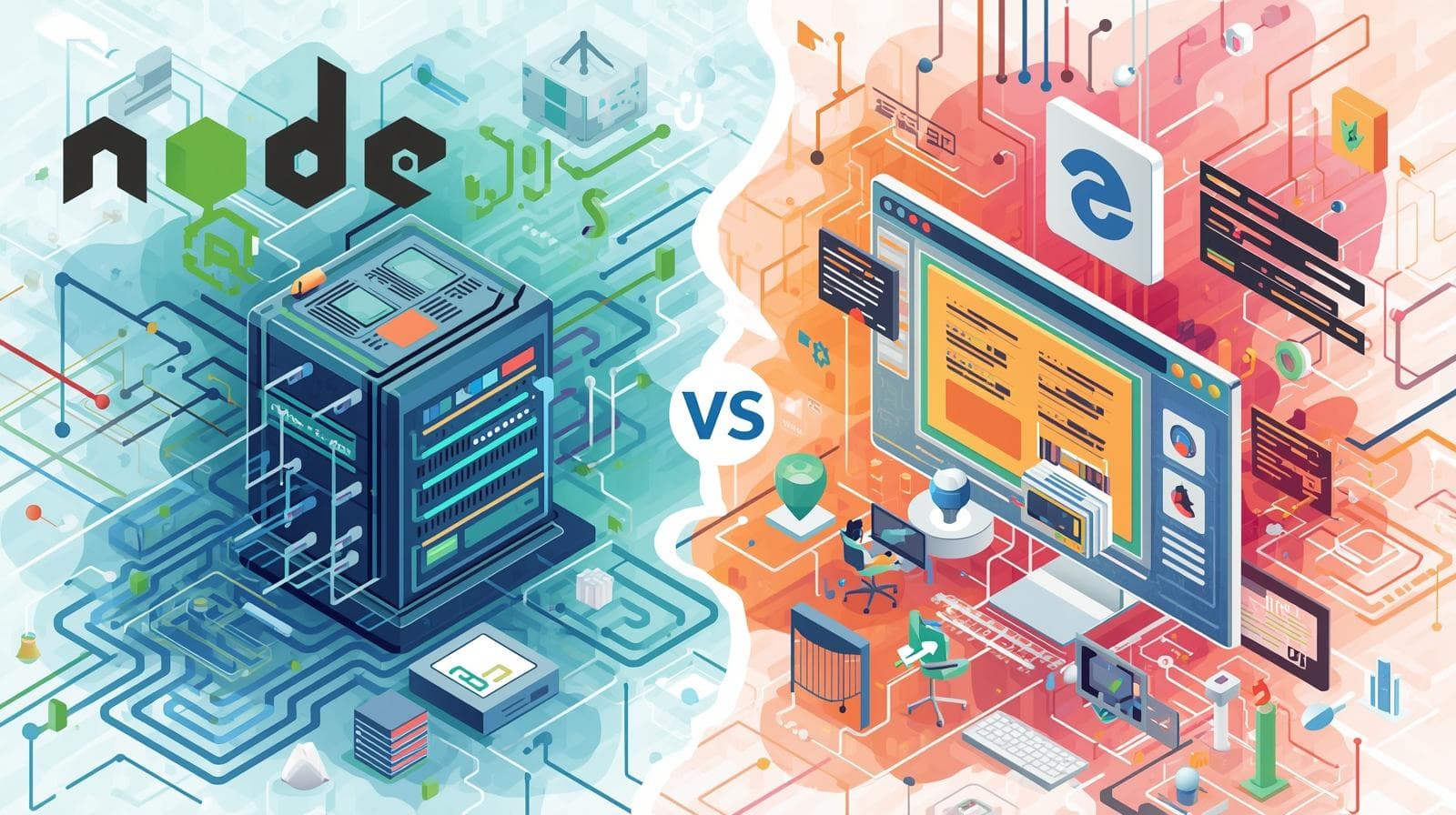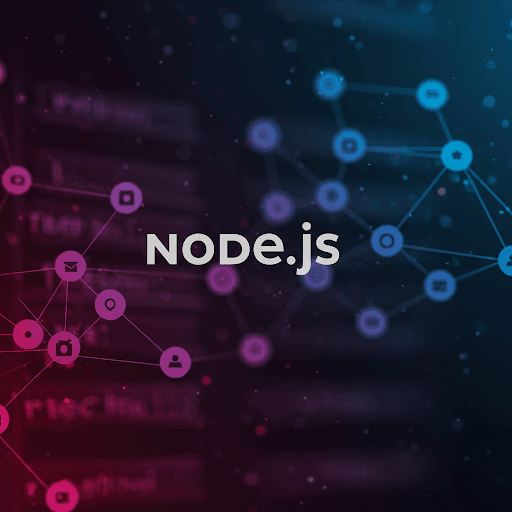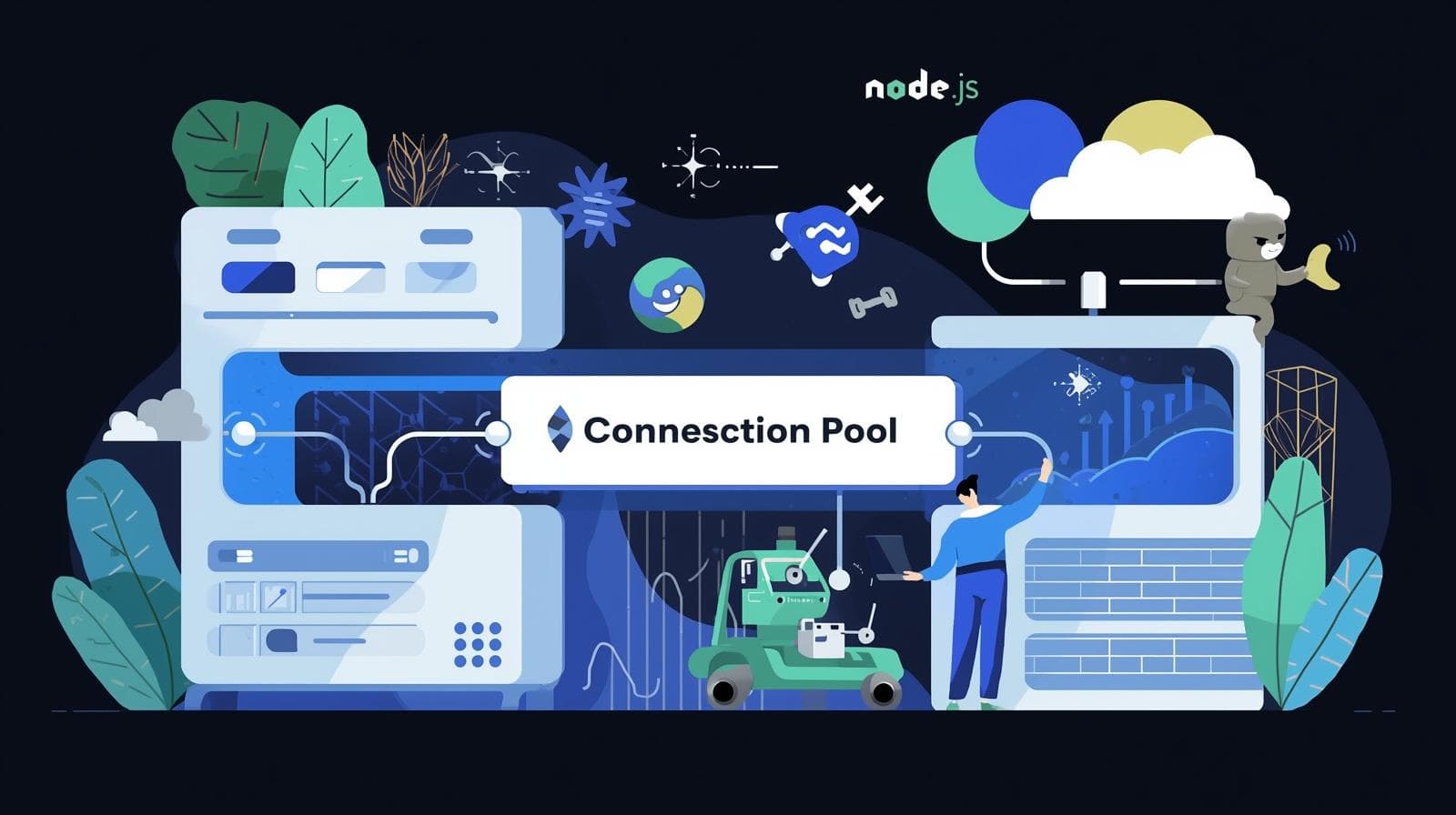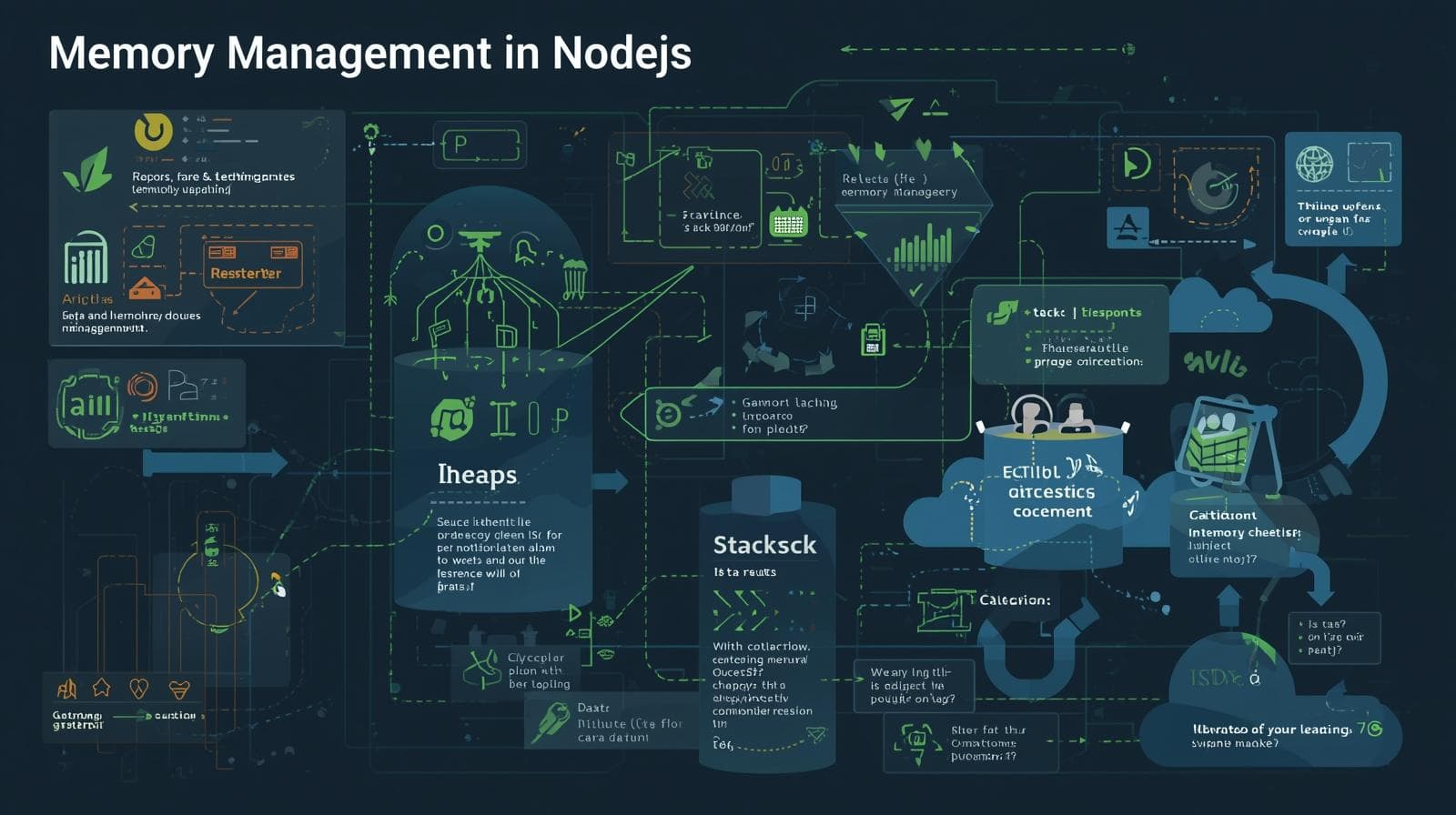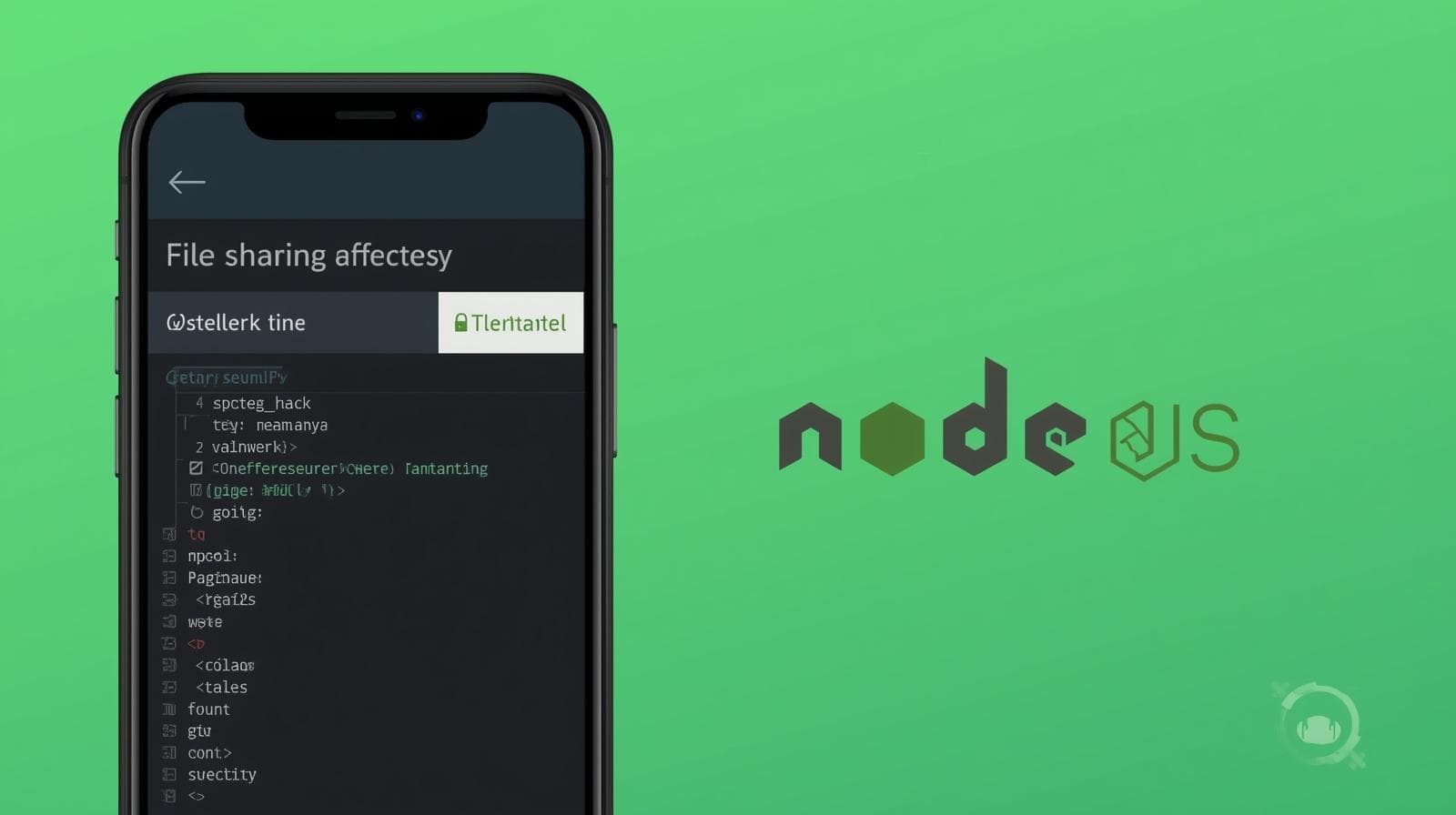Build a Scalable E-commerce Backend: A Node.js & MongoDB Guide
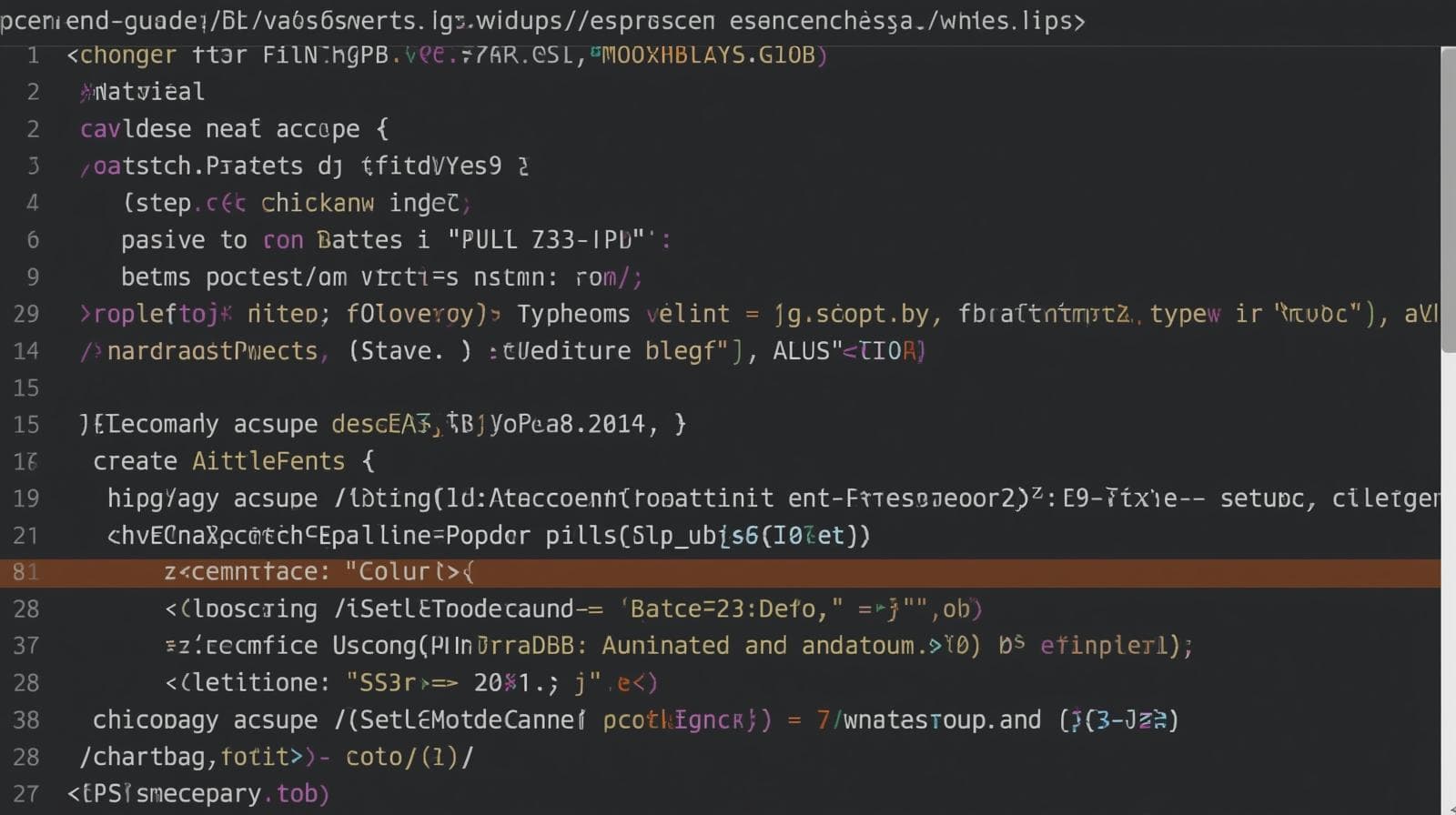
Dive deep into building a robust E-commerce backend with Node.js & MongoDB. This step-by-step guide covers APIs, security, payments, and best practices for future-proof web apps.
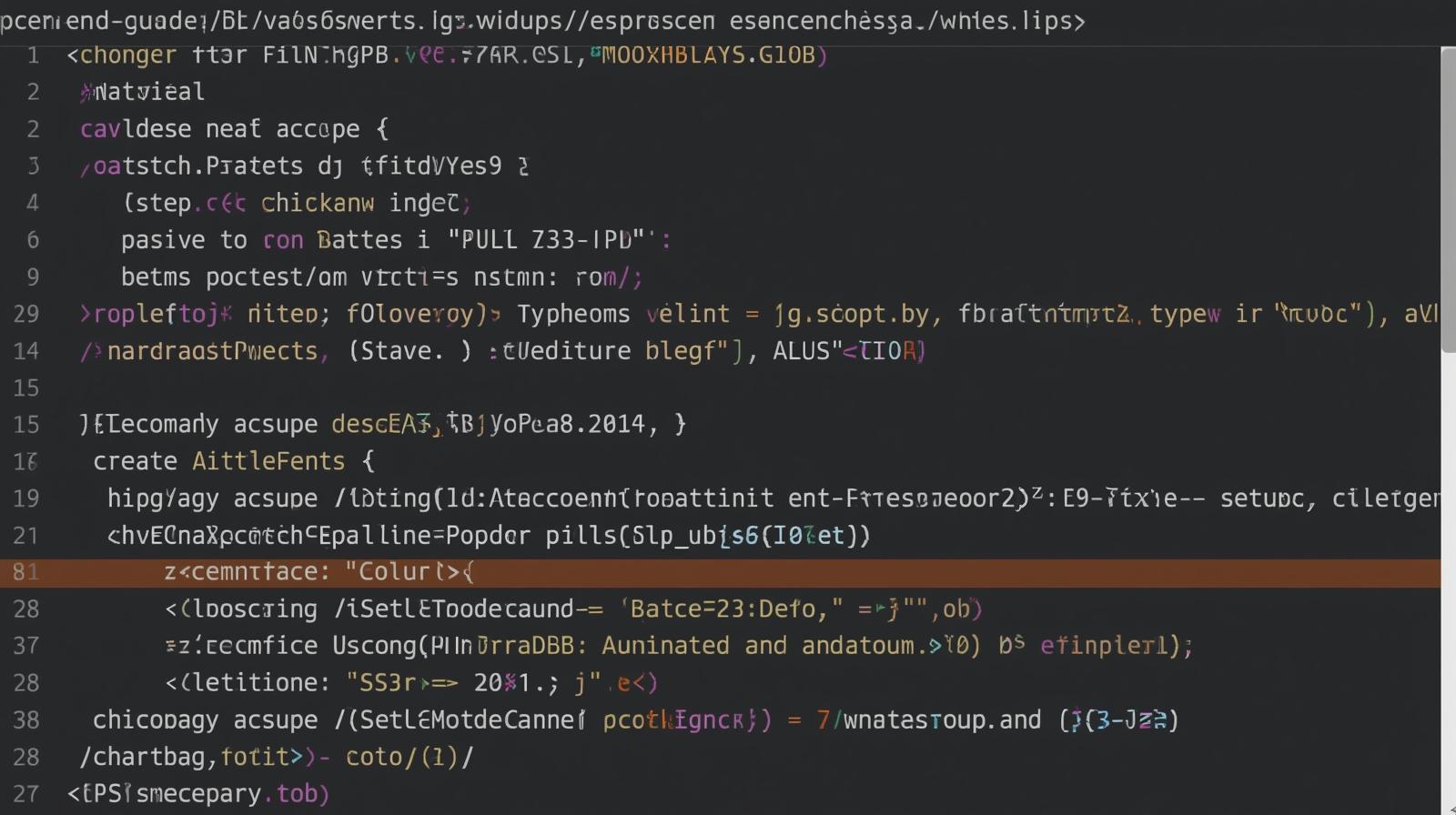
Build a Scalable E-commerce Backend: A Node.js & MongoDB Guide
Building a Scalable E-commerce Backend: Your Ultimate Guide with Node.js and MongoDB
Picture this: you have a brilliant idea for an online store. It could be for handmade crafts, cutting-edge tech gadgets, or a niche subscription box. The frontend design is crystal clear in your mind—sleek, intuitive, and beautiful. But what makes it all work? What powers the shopping cart, processes payments, secures user data, and manages inventory? The answer is the backend.
The backend is the engine room of your e-commerce ship. While the frontend is the shiny bridge that users interact with, the backend is where all the complex, critical logic happens. It's what separates a static brochure website from a dynamic, revenue-generating machine.
In this comprehensive guide, we're going to roll up our sleeves and dive deep into building a robust, scalable, and secure e-commerce backend using two of the most powerful technologies in the web development world: Node.js and MongoDB. Whether you're a budding developer or looking to solidify your backend skills, this journey will equip you with the practical knowledge to bring your e-commerce vision to life.
Why Node.js and MongoDB? The Perfect Match for E-commerce
Before we write a single line of code, let's understand our tools.
Node.js is a JavaScript runtime built on Chrome's V8 engine. It allows you to run JavaScript on the server, and its event-driven, non-blocking I/O model makes it exceptionally fast and efficient for handling multiple concurrent requests. For an e-commerce platform, this means you can manage thousands of users browsing, adding to cart, and checking out simultaneously without the server breaking a sweat.
MongoDB is a NoSQL database that stores data in flexible, JSON-like documents. Unlike traditional SQL tables with rigid rows and columns, MongoDB's documents can have varied structures. This is a game-changer for e-commerce. Think about a "Product" document: a t-shirt might have fields for size and color, while a book would have author and ISBN. MongoDB handles this heterogeneity with ease.
Together, they speak the same language: JavaScript. Using Node.js with MongoDB creates a unified development experience from the server to the database, streamlining the entire process and reducing context-switching for developers.
Laying the Foundation: Project Setup and Structure
Let's initialize our project. Open your terminal and create a new directory.
bash
mkdir ecommerce-backend
cd ecommerce-backend
npm init -yThis creates a package.json file to manage our dependencies. Now, let's install the core packages we'll need:
bash
npm install express mongoose bcryptjs jsonwebtoken cors dotenv
npm install --save-dev nodemonexpress: The minimal and flexible web application framework for Node.js.
mongoose: An ODM (Object Data Modeling) library for MongoDB and Node.js. It provides a straight-forward, schema-based solution to model your application data.
bcryptjs: To hash and salt user passwords, ensuring they are never stored in plain text.
jsonwebtoken: For generating JWTs, which are used to securely transmit information between the client and server as a JSON object. This is the core of our authentication system.
cors: Allows our API to be accessed from different domains (like our React/Vue frontend).
dotenv: Loads environment variables from a
.envfile intoprocess.env.nodemon: A development tool that automatically restarts the server when file changes are detected.
Now, create the basic structure of your project:
text
ecommerce-backend/
├── config/
│ └── db.js
├── controllers/
│ ├── authController.js
│ ├── productController.js
│ └── orderController.js
├── middleware/
│ ├── auth.js
│ └── error.js
├── models/
│ ├── User.js
│ ├── Product.js
│ └── Order.js
├── routes/
│ ├── auth.js
│ ├── products.js
│ └── orders.js
├── .env
├── server.js
└── package.jsonThis modular structure keeps our code organized, scalable, and easy to maintain—a crucial best practice for any serious project.
Building the Core: Data Models with Mongoose
Models are the blueprints for our data. They define the structure and enforce validation rules.
1. The User Model (models/User.js)
The user is at the heart of our system.
javascript
const mongoose = require('mongoose');
const bcrypt = require('bcryptjs');
const userSchema = new mongoose.Schema({
name: {
type: String,
required: [true, 'Please add a name'],
trim: true
},
email: {
type: String,
required: [true, 'Please add an email'],
unique: true,
lowercase: true,
match: [
/^\w+([\.-]?\w+)*@\w+([\.-]?\w+)*(\.\w{2,3})+$/,
'Please add a valid email'
]
},
password: {
type: String,
required: [true, 'Please add a password'],
minlength: 6,
select: false // This ensures the password is not returned by default in queries
},
role: {
type: String,
enum: ['user', 'admin'],
default: 'user'
},
address: {
street: String,
city: String,
state: String,
zipCode: String,
country: String
},
resetPasswordToken: String,
resetPasswordExpire: Date
}, {
timestamps: true // Automatically adds createdAt and updatedAt fields
});
// Encrypt password using bcrypt before saving
userSchema.pre('save', async function(next) {
// Only run this function if password was modified
if (!this.isModified('password')) {
next();
}
const salt = await bcrypt.genSalt(10);
this.password = await bcrypt.hash(this.password, salt);
});
// Match user entered password with hashed password in database
userSchema.methods.matchPassword = async function(enteredPassword) {
return await bcrypt.compare(enteredPassword, this.password);
};
module.exports = mongoose.model('User', userSchema);2. The Product Model (models/Product.js)
This is where we define our catalog.
javascript
const mongoose = require('mongoose');
const productSchema = new mongoose.Schema({
name: {
type: String,
required: [true, 'Please add a product name'],
trim: true,
maxlength: [100, 'Name cannot be more than 100 characters']
},
description: {
type: String,
required: [true, 'Please add a description'],
maxlength: [500, 'Description cannot be more than 500 characters']
},
price: {
type: Number,
required: [true, 'Please add a price'],
min: [0, 'Price must be a positive number']
},
category: {
type: String,
required: [true, 'Please add a category'],
enum: ['Electronics', 'Clothing', 'Books', 'Home & Garden', 'Sports']
},
image: {
type: String, // We'll store a URL to the image, typically from a service like AWS S3 or Cloudinary
default: '/images/no-image.jpg'
},
stock: {
type: Number,
required: true,
min: 0,
default: 0
},
seller: {
type: mongoose.Schema.ObjectId,
ref: 'User', // This links the product to the User who added it (an admin/seller)
required: true
},
ratings: {
type: Number,
min: 0,
max: 5,
default: 0
},
numReviews: {
type: Number,
default: 0
},
isActive: {
type: Boolean,
default: true // Soft delete feature
}
}, {
timestamps: true
});
module.exports = mongoose.model('Product', productSchema);3. The Order Model (models/Order.js)
The order model is the most complex, as it ties everything together.
javascript
const mongoose = require('mongoose');
const orderItemSchema = new mongoose.Schema({
name: { type: String, required: true },
quantity: { type: Number, required: true },
image: { type: String, required: true },
price: { type: Number, required: true },
product: {
type: mongoose.Schema.ObjectId,
ref: 'Product',
required: true
},
});
const orderSchema = new mongoose.Schema({
user: {
type: mongoose.Schema.ObjectId,
ref: 'User',
required: true
},
orderItems: [orderItemSchema], // An array of order items
shippingAddress: {
address: { type: String, required: true },
city: { type: String, required: true },
zipCode: { type: String, required: true },
country: { type: String, required: true }
},
paymentMethod: {
type: String,
required: true,
enum: ['stripe', 'paypal'] // Can be extended
},
paymentResult: {
id: String, // Payment intent ID from Stripe
status: String,
update_time: String,
email_address: String,
},
itemsPrice: {
type: Number,
required: true,
default: 0.0
},
taxPrice: {
type: Number,
required: true,
default: 0.0
},
shippingPrice: {
type: Number,
required: true,
default: 0.0
},
totalPrice: {
type: Number,
required: true,
default: 0.0
},
isPaid: {
type: Boolean,
required: true,
default: false
},
paidAt: {
type: Date
},
isDelivered: {
type: Boolean,
required: true,
default: false
},
deliveredAt: {
type: Date
}
}, {
timestamps: true
});
// Instance method to calculate prices (could also be done in the controller)
orderSchema.methods.calculatePrices = function() {
this.itemsPrice = this.orderItems.reduce((acc, item) => acc + item.price * item.quantity, 0);
// Example tax and shipping logic
this.taxPrice = Number((this.itemsPrice * 0.15).toFixed(2)); // 15% tax
this.shippingPrice = this.itemsPrice > 100 ? 0 : 10; // Free shipping over $100
this.totalPrice = Number((this.itemsPrice + this.taxPrice + this.shippingPrice).toFixed(2));
};
module.exports = mongoose.model('Order', orderSchema);Implementing Business Logic: Controllers and Routes
With our models ready, let's implement the logic that handles incoming HTTP requests.
1. Authentication System (Register/Login)
First, let's create a middleware to protect our routes (middleware/auth.js).
javascript
const jwt = require('jsonwebtoken');
const User = require('../models/User');
// Protect routes - check for valid JWT
exports.protect = async (req, res, next) => {
let token;
if (req.headers.authorization && req.headers.authorization.startsWith('Bearer')) {
// Set token from Bearer token in header
token = req.headers.authorization.split(' ')[1];
}
// Make sure token exists
if (!token) {
return res.status(401).json({ success: false, message: 'Not authorized to access this route' });
}
try {
// Verify token
const decoded = jwt.verify(token, process.env.JWT_SECRET);
req.user = await User.findById(decoded.id); // Attach the full user object to the request
next();
} catch (err) {
return res.status(401).json({ success: false, message: 'Not authorized to access this route' });
}
};
// Grant access to specific roles
exports.authorize = (...roles) => {
return (req, res, next) => {
if (!roles.includes(req.user.role)) {
return res.status(403).json({
success: false,
message: `User role ${req.user.role} is not authorized to access this route`
});
}
next();
};
};Now, the auth controller (controllers/authController.js):
javascript
const User = require('../models/User');
const jwt = require('jsonwebtoken');
// Generate JWT Token
const sendTokenResponse = (user, statusCode, res) => {
const token = jwt.sign({ id: user._id }, process.env.JWT_SECRET, {
expiresIn: process.env.JWT_EXPIRE,
});
const options = {
expires: new Date(Date.now() + process.env.JWT_COOKIE_EXPIRE * 24 * 60 * 60 * 1000),
httpOnly: true,
};
// Send cookie in production over HTTPS
if (process.env.NODE_ENV === 'production') {
options.secure = true;
}
res
.status(statusCode)
.cookie('token', token, options)
.json({
success: true,
token,
user: {
id: user._id,
name: user.name,
email: user.email,
role: user.role
}
});
};
// @desc Register user
// @route POST /api/auth/register
// @access Public
exports.register = async (req, res, next) => {
try {
const { name, email, password, role } = req.body;
// Create user
const user = await User.create({
name,
email,
password, // This will be hashed by the pre-save middleware in the model
role,
});
sendTokenResponse(user, 200, res);
} catch (err) {
res.status(400).json({ success: false, message: err.message });
}
};
// @desc Login user
// @route POST /api/auth/login
// @access Public
exports.login = async (req, res, next) => {
try {
const { email, password } = req.body;
// Validate email & password
if (!email || !password) {
return res.status(400).json({ success: false, message: 'Please provide an email and password' });
}
// Check for user, explicitly selecting the password field which is normally `select: false`
const user = await User.findOne({ email }).select('+password');
if (!user) {
return res.status(401).json({ success: false, message: 'Invalid credentials' });
}
// Check if password matches
const isMatch = await user.matchPassword(password);
if (!isMatch) {
return res.status(401).json({ success: false, message: 'Invalid credentials' });
}
sendTokenResponse(user, 200, res);
} catch (err) {
res.status(400).json({ success: false, message: err.message });
}
};And the corresponding routes (routes/auth.js):
javascript
const express = require('express');
const { register, login } = require('../controllers/authController');
const router = express.Router();
router.post('/register', register);
router.post('/login', login);
module.exports = router;2. Product Management
Let's create controllers to manage our product catalog (controllers/productController.js).
javascript
const Product = require('../models/Product');
// @desc Get all products
// @route GET /api/products
// @access Public
exports.getProducts = async (req, res, next) => {
try {
// Filtering, Sorting, Pagination
const pageSize = 10;
const page = Number(req.query.pageNumber) || 1;
const keyword = req.query.keyword
? {
name: {
$regex: req.query.keyword,
$options: 'i', // case-insensitive
},
}
: {};
const count = await Product.countDocuments({ ...keyword, isActive: true });
const products = await Product.find({ ...keyword, isActive: true })
.limit(pageSize)
.skip(pageSize * (page - 1))
.populate('seller', 'name email'); // Populate seller info
res.json({
success: true,
products,
page,
pages: Math.ceil(count / pageSize),
count,
});
} catch (error) {
res.status(500).json({ success: false, message: 'Server Error' });
}
};
// @desc Get single product
// @route GET /api/products/:id
// @access Public
exports.getProduct = async (req, res, next) => {
try {
const product = await Product.findById(req.params.id).populate('seller', 'name email');
if (!product || !product.isActive) {
return res.status(404).json({ success: false, message: 'Product not found' });
}
res.json({ success: true, product });
} catch (error) {
res.status(500).json({ success: false, message: 'Server Error' });
}
};
// @desc Create a product
// @route POST /api/products
// @access Private/Admin
exports.createProduct = async (req, res, next) => {
try {
req.body.seller = req.user.id; // The logged-in user is the seller
const product = await Product.create(req.body);
res.status(201).json({ success: true, product });
} catch (error) {
res.status(400).json({ success: false, message: error.message });
}
};
// ... (Add updateProduct and deleteProduct/soft-delete controllers)The product routes (routes/products.js):
javascript
const express = require('express');
const {
getProducts,
getProduct,
createProduct,
updateProduct,
deleteProduct,
} = require('../controllers/productController');
const { protect, authorize } = require('../middleware/auth');
const router = express.Router();
router.route('/')
.get(getProducts)
.post(protect, authorize('admin'), createProduct);
router.route('/:id')
.get(getProduct)
.put(protect, authorize('admin'), updateProduct)
.delete(protect, authorize('admin'), deleteProduct);
module.exports = router;Integrating Payments: The Checkout Process with Stripe
No e-commerce backend is complete without a payment gateway. We'll use Stripe, one of the most popular and developer-friendly options.
First, install the Stripe Node.js library:
bash
npm install stripeNow, let's create an order controller for checkout (controllers/orderController.js).
javascript
const Order = require('../models/Order');
const Product = require('../models/Product');
const stripe = require('stripe')(process.env.STRIPE_SECRET_KEY);
// @desc Create new order & Stripe payment intent
// @route POST /api/orders
// @access Private
exports.createOrder = async (req, res, next) => {
try {
const { orderItems, shippingAddress, paymentMethod } = req.body;
if (orderItems && orderItems.length === 0) {
return res.status(400).json({ success: false, message: 'No order items' });
}
// 1. Create the order in our database with status 'unpaid'
const order = new Order({
orderItems,
user: req.user._id,
shippingAddress,
paymentMethod,
});
// Calculate prices
order.calculatePrices();
// Save the unpaid order
const createdOrder = await order.save();
// 2. Create a Stripe Payment Intent
const lineItems = orderItems.map(item => ({
price_data: {
currency: 'usd',
product_data: {
name: item.name,
images: [item.image],
},
unit_amount: Math.round(item.price * 100), // Stripe expects amounts in cents
},
quantity: item.quantity,
}));
const session = await stripe.checkout.sessions.create({
payment_method_types: ['card'],
line_items: lineItems,
mode: 'payment',
success_url: `${process.env.CLIENT_URL}/order/success?session_id={CHECKOUT_SESSION_ID}`,
cancel_url: `${process.env.CLIENT_URL}/cart`,
metadata: {
order_id: createdOrder._id.toString(), // Crucial for webhook to identify the order
},
});
// 3. Send the session ID to the client
res.json({ success: true, sessionId: session.id });
} catch (error) {
res.status(500).json({ success: false, message: error.message });
}
};
// @desc Stripe Webhook - Fulfill the order after successful payment
// @route POST /api/orders/webhook
// @access Public (but secured by Stripe signature)
exports.webhook = async (req, res, next) => {
const sig = req.headers['stripe-signature'];
let event;
try {
// Verify the webhook signature
event = stripe.webhooks.constructEvent(req.body, sig, process.env.STRIPE_WEBHOOK_SECRET);
} catch (err) {
console.log(`Webhook signature verification failed.`, err.message);
return res.status(400).send(`Webhook Error: ${err.message}`);
}
// Handle the checkout.session.completed event
if (event.type === 'checkout.session.completed') {
const session = event.data.object;
// Find the order and update its status
const order = await Order.findById(session.metadata.order_id);
if (order) {
order.isPaid = true;
order.paidAt = Date.now();
order.paymentResult = {
id: session.payment_intent,
status: session.payment_status,
email_address: session.customer_details.email,
};
// Update product stock
for (const item of order.orderItems) {
const product = await Product.findById(item.product);
product.stock -= item.quantity;
await product.save();
}
const updatedOrder = await order.save();
console.log(`Order ${updatedOrder._id} marked as paid.`);
}
}
res.json({ received: true });
};This controller does two critical things:
Creates a Payment Intent: It takes the order details, creates a corresponding order in our database, and then uses Stripe to create a "Checkout Session." This session ID is sent back to the frontend, which redirects the user to Stripe's secure payment page.
Handles the Webhook: After a successful payment, Stripe sends a webhook event to our server. We verify this event and then update our database order to mark it as 'paid' and reduce the product stock. This is more reliable than relying on the client to confirm payment.
Real-World Use Cases and Best Practices
Building the API is one thing; making it production-ready is another. Here are some crucial considerations:
Inventory Management: Our webhook automatically reduces stock upon successful payment, preventing overselling.
Error Handling: We've used basic try-catch blocks, but for a larger app, consider a centralized error handling middleware.
Security:
Data Validation: Use a library like
Joiorexpress-validatorfor robust request data validation.Sanitization: Sanitize user input to prevent NoSQL injection (e.g., using
express-mongo-sanitize).Rate Limiting: Prevent brute-force attacks on login/register endpoints using
express-rate-limit.Helmet: Secure your app by setting various HTTP headers using
helmet.
Performance:
Indexing: Create database indexes on frequently queried fields (e.g.,
Product.category,Order.user).Pagination: We implemented pagination in the
getProductscontroller to avoid sending thousands of records at once.Caching: Use Redis to cache frequently accessed data, like product lists or user sessions.
Deployment and Beyond
Once your backend is built and tested locally, it's time to deploy it. You can use platforms like:
Heroku: Great for simplicity and getting started quickly.
AWS Elastic Beanstalk / Google App Engine: Managed service platforms that handle scaling.
DigitalOcean App Platform / Railway: Modern, developer-friendly deployment platforms.
Remember to set your environment variables (like JWT_SECRET, STRIPE_SECRET_KEY, MONGODB_URI) securely in your production environment.
Frequently Asked Questions (FAQs)
Q1: Why not use a SQL database like PostgreSQL?
Both are excellent choices. MongoDB's flexible schema is great for evolving product catalogs. However, SQL databases are superior for complex transactions and reporting. The choice often depends on your specific data consistency requirements.
Q2: How do I handle file uploads for product images?
You can use middleware like multer to handle file uploads on your server and then upload the file to a cloud storage service like AWS S3, Google Cloud Storage, or Cloudinary, which will return a URL to store in your database.
Q3: This is a lot. Is there a simpler way?
For a quick start, you can use platforms like Shopify or Magento. However, building a custom backend gives you unparalleled control, flexibility, and the ability to create unique user experiences tailored to your business needs. It's also a fantastic way to develop in-demand software engineering skills.
Q4: How can I learn to build projects like this from scratch?
Structured learning is key to mastering full-stack development. To learn professional software development courses such as Python Programming, Full Stack Development, and MERN Stack, visit and enroll today at codercrafter.in. Our project-based curriculum is designed to take you from beginner to job-ready developer.
Conclusion
Building an e-commerce backend is a challenging but incredibly rewarding endeavor. We've walked through the core components: setting up a Node.js server, designing flexible data models with MongoDB, implementing JWT-based authentication, creating a RESTful API for products and orders, and integrating a secure payment gateway with Stripe.
This guide provides a solid foundation, but remember, a real-world system would include many more features: email notifications, a robust review and rating system, advanced search with Elasticsearch, recommendation engines, and a full-fledged admin panel.
The journey of a backend developer is one of continuous learning and problem-solving. You've now got the blueprint. Start building, experiment, and don't be afraid to break things—it's the best way to learn.
Ready to turn your ideas into fully functional web applications? Dive deeper into the world of modern development with our comprehensive courses. To learn professional software development courses such as Python Programming, Full Stack Development, and MERN Stack, visit and enroll today at codercrafter.in. Let's build the future, together.

